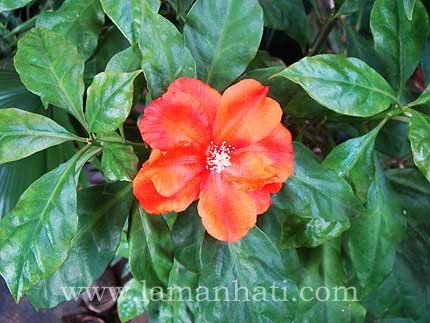Jarum Tujuh – Pereskia sacharosa/saecnarosa
When I was given this plant (or rather the cutting of it) by MIL, she told me that it is called Jarum Tujuh and has the medicinal benefit to cure cancer. Since I collected herbal plants, I decided to try and plant it.

It does has sharp thorns along its thin stems, thus the name of Jarum Tujuh. It is said that there are 7 thorns or spines along one stem (which I can’t vouch for since I never check and count it..heh). Some people eat the crunchy leaves or make tea out of it to cure colon, nose and other type of cancer. It is also known as Bintang Tujuh, Cancer Plant and Chat Sim Chan.

Further reading, I found out that Pereskia is a genus of about 25 tropical species and varieties of cacti that do not look much like other types of cacti. Pereskia is the only cactus genus that has persistent non-succulent leaves. It is believed that this is the origin of other cacti.
It propagates through cuttings and seeds. Since the leaves are non-succulent, they drop easily if they don’t get enough water or if it is too hot or dry but can grow back quickly once they get sufficient watering.
UPDATED 25th June 2010: The correct name for this plant is Pereskia bleo.
Taken from a Pharmacognosy journal online:
Pereskia bleo and Pereskia grandifolia, commonly known as ‘Jarum Tujuh Bilah’ in Malaysia belong to the botanical family Cactaceae. Pereskia bleo can be easily confused with Pereskia grandifolia because they are vegetatively similar. However, they can be easily distinguished by the leaves, flowers, and spines. Pereskia bleo has thinner, corrugated leaves, and orangish-red flowers, with shorter spines compared to Pereskia grandifolia. In contrast, Pereskia grandifolia has thicker, uncorrugated leaves, and pink to purplish-pink flowers, with longer and lesser spines.
Hi, can you send me the jarum bintang tujuh i would like to plant it. As i have a father who got stroke i would like to give to him. Please email me if you can send me i will give you my address. Many thanks in advance.
I just recently knew about this plant. There is a plant growing in my school compund. Where do you live?
I’m from Malacca.
Hi, i’m planning to do a research on this plant for my final year project. Do u know where i can get the supply for their leaves? I just need the leaves for extraction. Hope u can help. Thanks 4 ur help. Hope2 hear from u soon…
This plant is not Pereskia sacharosa but Pereskia bleo. Like all members of the cactus family the genus Pereskia is native to Tropical America. In Malaysia and Singapore, P. bleo is frequently mis-identified as P. sacharosa, but in fact P. sacharosa (which has pink flowers) is extremely rare in cultivation.
Marc S. Frank
Manager Living Collections
Singapore Botanic Gardens
Marc, thank you for the info. I will look up about Pereskia bleo. It is very hard to identify the correct name for all that plants that I bought and grew at home.
Hi, I have a Pereskia bleo in my garden. Â It doesn’t bloom as pften as I’d like it to be? Could it because it is under partial shade?
Mine is now under partial shade as well and didn’t bloom for the past one year. Maybe you can try to change the spot and see whether more sun will work to make it bloom 🙂
I can potted the pereskia plants those who like to buy them pls call me tele 94+o776315633